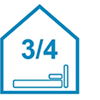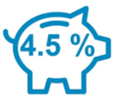If you plan to ever buy another investment property this is a must use checklist. It has saved our clients millions of pounds of investment mistakes over the years.
When I first started investing in property my first 10 properties were a nightmare. I had tenants not paying, people trashing my properties, they were hard to rent. And worst of all it was someone else’s money I was investing with and losing – not mine! It was only when I committed to mastery – modelling and copying the very best that I started to get great results. The Six C’s started to guarantee me that I would only ever buy world class properties. I would never need to put any money in to a property again after buying it and it would make me money whether the market was flat or rising. I won either way.
Having 150+ properties in my own portfolio and having helped our clients buy over 1500 properties in the last decade using the Six C’s they only buy outstanding properties. They mean we reject 99 out of 100 houses that other investors would buy. But the ones we do buy are world class. People go out to select a buy to let. They may look at 10 online, then view 5 and then buy 1 – this is crazy. Use the checklist to save time and effort by rejecting and deselecting as many as you can, so you only view ones that meet all the rules.
Below are the golden rules – follow these to guarantee successful investing. Deselect, deselect, deselect. Reject and reject until what is left are only outstanding properties.

CAPACITY
Your property needs to be a 3 or 4 bedroom property. Not a 1 bedroom or 2 bedroom flat or house.
With 1 bedroom you get too much transiency. Someone will meet a new partner and fall in love and so they move out. With 2 bedrooms a family have 1 child but then they get pregnant and have another – and move out. The average tenant change costs you £1,500. If you buy a property that changes once per year that is a £15,000 cost over a decade.
You need to buy properties where the tenants want to stay for life. Mum lives up the road, uncle lives down the road and kids are at the local secondary school.

CITY
Do not just buy in your town. Buy in the area that gives you the best investment return. If I only bought Morrisons stocks and shares because I come from Yorkshire and they are based there you would laugh at me. When you buy a stock or share you want the best possible return on investment. It is the same with your property investing. So which area will give you the best return. An example to help you think this though.
If I drive 30 miles from my front door I arrive in York. I can buy a 3 bedroom property for 150k that will rent for £700 per month. If I drive 6 miles the other way, I can use the same money to buy 2 properties worth 75k each in Scarborough. They rent for £560 per month each = £1,120 per month. Over time the prices in each town go up the same – I know as I have studied that. York is a year ahead but they go up the same. So I know I would rather have the extra £420 per month = £5,000 per year while they go up! By the way I am not saying buy in Scarborough – there can be even better places than that.

CAPITAL
The UK house prices go up at 7.9% per annum on average. That includes all the downturns, drops, flat periods. Its 7.9% a year on average. So the national average is pretty good – you just need to make sure you get that. Here is how:
- Buy in a town or a city (population 80,000+)
- Buy within 5 miles of the town or city centre (measured by town hall or train station) – 7 miles if Manchester or London
- Buy close to a great secondary school (Ofsted needs to be good or outstanding)
- Buy on a good public transport network – bus, tram, train
- Buy on a great road network
If you buy in a village and the local factory shuts with 100 people losing their job, micro-economics kicks in and you get no price rises for 10 years.

CASHFLOW
Once you buy an investment property you should never need to put money into the deal again. NEVER. You do this by ensuring you buy them with enough great cash flow. Now obviously we want them to have as much cash flow as possible – but what is the rule they have to pass?
Rent – see what the rent is for this particular property.
Mortgage – we can get crazy rates these days but do the mortgage at 4% (interest only) for your cash flow check as you then know it will cover you for at least the next 5-8 years based on what banks are currently charging.
Maintenance – £80 per month (we manage hundreds so we know).
Insurance – put £20 per month (you can often get a little cheaper)
Letting agent (budget 11% +VAT) – you may choose to manage it yourself but what if you get ill.
Your cash flow check – you assume the property is empty for 1 month a year. So rented January to November and empty in December. In this example with £120 profit per month by the end of November you would have £120 x 11 = £1,320. This number MUST be higher than the rent for month 12 (in this example £600pm rent). If the £1,320 of profit covers the rent in month 12 if it is empty, then it has passed this check. If it does not pass it then do not buy the property.

CHECK
This is the biggest one missed by even serious investors. You don’t need to now. Check your property will always rent well before you buy it.
So as soon as you agree to buy a property then advertise it to rent. You can use Zoopla or the local newspaper and advertise the property. You are looking for 10 replies within a week otherwise you walk away. I don’t care how many other of the Six C’s it meets if it does not pass this do not buy it.
If 5 people are interested and 3 view it and 1 wants it they have chosen you – you did not choose them! But if 20 people are interested and 10 view it and 5 want it now you can ask for bank statements, wage slips, guarantors – the works!

CONTINGENCY
Finally, do not put every single penny you have into your property investing. Always keep 4.5% as a buffer to protect you. So, if you are investing 100k then actually use 95.5k to buy the properties and get them all up and running and keep 4.5% in the rainy day contingency fund.
If its £1,000,000 you are investing, then actually use £955,000 and keep £45,000 to protect the investment. Any great business has contingency to protect it!
